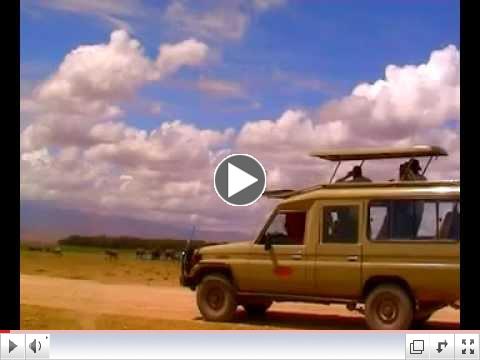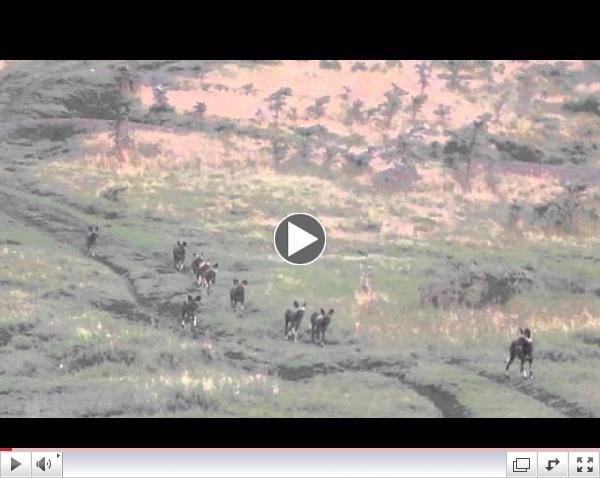| Dear Dr. Wolfgang,
Greetings Porini Enthusiast!
The grass is brittle, the rivers are flowing. The currents are rushing, the ground is shaking. I can hear them. They are restless. They wait around in uneasy circles, look out into the endless horizon, sniff the air for wild scents. No one dares take that first step to the other side. But the new grass IS on the other side. Temptation is strong. Hunger calls… So be it! Throwing caution to the wind, one of the shaggy "beasts" makes the leap into the unknown, and so it begins …The great migrating cycle of the Serengeti – Mara eco system. The high season is here. Dramatic kills! Exciting chases! Enthralling river plunges! The wild is calling us like the cry of a cub wanting its mother.
Feel the wildbeest migration and hear it! These creatures mould the eco system as they run from one to the other. Their hooves crop grass. Their droppings fertilize the land, and they are protein for many predators.
I was in Olare Motorogi early this month and caught a feast! What a thrill to be the only vehicle to witness to such a magnificent moment! Read on for a sequence of events…
 |
| "The Feast" |
Karibu to Porini…
Aleema
Aleema Noormohamed
Marketing Executive
Porini Safari Camps |
| World Travel Awards
World Travel Awards serves to acknowledge, reward and celebrate excellence across all sectors of the global travel and tourism industry.
Gamewatchers and Porini Camps have been nominated for 3 awards!
Please register for an account and cast your vote.
We really appreciate and thank you for your continued support!
Voting ends on August 25th, 2013.

PLEASE VOTE FOR US IN THESE 3 CATEGORIES
"Africa’s Responsible Tourism Award"
"Kenya’s Leading Inbound Tour Operator"
"Kenya’s Leading Safari Camp Brand"
|
Featured Camp –
Porini Amboseli Camp

Porini Amboseli Camp: 9 spacious tents. Small and exclusive. It is set up along the lines of the traditional hunting safari bush camp. Tents are large and comfortably furnished. En suite bathroom with safari shower, wash basin and flush toilet. The camp is staffed entirely by members of the local Maasai community apart from the manager and head chef. Porini Amboseli Camp has a prestigious GOLD eco-rating and was also the Eco Rated Facility of the Year in 2011. For more information, please click here.
There is an authentic Maasai Village that guests can visit whilst they stay at Porini Amboseli Camp. We work very closely with the communities and encourage guests who are interested in helping these communities, to support the outreach programs that we manage to create benefits for these communities rather than having guests giving individual handouts.
Porini Amboseli Camp Highlights
 |
| Porini Amboseli Camp Highlights Featuring Interviews with Maasai Villagers and Camp Guests |
|
Conservancy Update – Wild Dogs in Ol Pejeta Conservancy home of Porini Rhino Camp
 |
| Wild dogs spotted |
Wild dogs are being regularly seen by our clients staying at Porini Rhino Camp and for those that haven’t seen wild dogs, book a stay with your agent at Porini Rhino Camp for an excellent chance to see these beautiful and highly successful hunters. The wild dogs have made Ol Pejeta their home, and over the last year and half, there have been 2 litters of pups born in Ol Pejeta. Prior to this, wild dogs haven’t been seen in the conservancy for a very long time and there are currently 14 wild dogs that call Ol Pejeta home.
African wild dogs have seen a decrease in their number due to habitat loss and hunting. They are threatened by habitat fragmentation, road casualties, poisoning, snaring and are even in competition for prey by larger carnivores. They now only live in the savannahs and grasslands, making them Africa’s most endangered predator.
In Kenya, approximately only six percent of wild dogs’ historical range might still support resident populations.
DID YOU KNOW?
The Latin name for the species, Lycaon pictus, means "painted wolf," referring to the dogs’ mottled coat. Puppies are born with a black and white coat that begins to change to a distinctively patterned coat of black, tan, dark brown, and white at about a month old. Like a human fingerprint, no two dogs’ coats are the same. African wild dogs differ from their other canid relatives in that they have four toes on their front feet instead of five. They have long legs and a lanky body, which gives the dogs both speed and endurance. Their large, rounded ears provide them with excellent hearing and help keep the dogs cool in warm climates. African wild dogs have a social structure similar to wolves’ social structure but seem to be gentler within their pack. Some social carnivores keep the peace by using aggressive posturing to keep subordinates in line, whereas wild dogs seem to do the opposite. Exaggerated submissive posturing and greeting ceremonies reinforce the pack social structure. Each pack has a dominant male and female, but all adult members help raise pups and care for sick or elderly members of the group.
**The above information has been kindly provided by Ol Pejeta Conservancy** |
| The lesser known Loita Migration
The migration of over one million wildebeest, and thousands of eland, Thompson’s gazelle and Burchell’s zebra from the Serengeti Plains to the Masaai Mara is an annual phenomenon known to most passionate about wildlife. But the crowds, and booking of accommodation, months if not a year in advance make the dream of seeing this spectacle a rather difficult feat for most tourists.
But the thundering sound of herbivore hooves on the African Savannah while crossing rivers in search of greener pastures is not limited to the larger Masaai Mara National Reserve. The migration of between 300,000 and 500,00 zebra and wildebeest arrives in Ol Kinyei Conservancy home to Porini Mara Camp and the Gamewatchers Ol Kinyei Adventure Camp from the Loita Plains, which is located northeast of the Reserve, between June and July.

Naturally, this spectacle is determined by the availability of grazing land which is also dependent on rainfall. Typically, the wildebeests move north-west from the short grassy lands of the Serengeti and Grumeti River. This crossing is their first real test to get to the other side without being feasted upon by the crocs! The herds keep moving north, eventually reaching the Kenyan border in the Maasai Mara. Here again, our friends face a fate only be-known to those few, who know deep in their hearts, today may be their last day on earth.
The mass of the groaning beasts remain in the Mara grasslands until October or November. As the storms start to gather in the Serengeti, the herds return to their breeding grounds. By the time they calm their thumping hearts and slow their journey, the grounds are once again green and lush, and this is now a return to the beginning…in a few months, the parade across the East African borders will repeat in its never-ending cycle.
With predator populations within the Conservancy growing, guests are sure to have a true safari experience with fewer crowds and enjoy the breathtakingly beautiful landscapes that the conservancies of the Mara ecosystem have to offer. Call your agent for more information.
Check out this amazing video on the Wildebeest’s struggle to remain alive. |
Action in Porini – The Wildebeest Feast
 |
| The Catch |
 |
| The Big Feast |
 |
| The Satisfaction |
 |
| The Last Meal |
|
| What are we up to
Meet our guide at Porini Amboseli Camp: Wilson Kasaine.
Wilson is a silver rated guide with a passion for tourism and wildlife. He has a certificate in travel and tourism, and has proven to be a dedicated and animated guide that guests love to interact with. |
|
|
|


